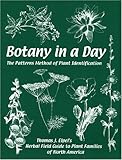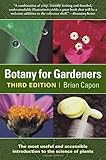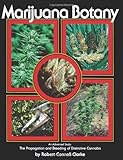|
|
Help |
| Home - Biology - Botany (Books) | |
e99 Online Shopping Mall
|
|
Help |
| Home - Biology - Botany (Books) | |
| 1-20 of 103 | Next 20 |
click price to see details click image to enlarge click link to go to the store
| 1. The Botany of Desire: A Plant's-Eye View of the World by Michael Pollan | |
 | Paperback: 271
Pages
(2002-05-28)
list price: US$16.00 -- used & new: US$4.93 (price subject to change: see help) Asin: 0375760393 Average Customer Review: Canada | United Kingdom | Germany | France | Japan |
|
Editorial Review Product Description In making his point, Pollan focuses on the relationship between humans and four specific plants: apples, tulips, marijuana, and potatoes. He uses the history of John Chapman (Johnny Appleseed) to illustrate how both the apple's sweetness and its role in the production of alcoholic cider made it appealing to settlers moving west, thus greatly expanding the plant's range. He also explains how human manipulation of the plant has weakened it, so that "modern apples require more pesticide than any other food crop." The tulipomania of 17th-century Holland is a backdrop for his examination of the role the tulip's beauty played in wildly influencing human behavior to both the benefit and detriment of the plant (the markings that made the tulip so attractive to the Dutch were actually caused by a virus). His excellent discussion of the potato combines a history of the plant with a prime example of how biotechnology is changing our relationship to nature. As part of his research, Pollan visited the Monsanto company headquarters and planted some of their NewLeaf brand potatoes in his garden--seeds that had been genetically engineered to produce their own insecticide. Though they worked as advertised, he made some startling discoveries, primarily that the NewLeaf plants themselves are registered as a pesticide by the EPA and that federal law prohibits anyone from reaping more than one crop per seed packet. And in a interesting aside, he explains how a global desire for consistently perfect French fries contributes to both damaging monoculture and the genetic engineering necessary to support it. Pollan has read widely on the subject and elegantly combines literary, historical, philosophical, and scientific references with engaging anecdotes, giving readers much to ponder while weeding their gardens.--Shawn Carkonen Customer Reviews (199)
| |
| 2. Botany in a Day:The Patterns Method of Plant Identification by Thomas J. Elpel | |
 | Paperback: 221
Pages
(2004-01)
list price: US$30.00 -- used & new: US$18.65 (price subject to change: see help) Asin: 1892784157 Average Customer Review: Canada | United Kingdom | Germany | France | Japan |
|
Editorial Review Product Description Instead of trying to identify plants one-at-a-time, Botany in a Day give you a way to learn them by the hundreds, based on the principle that related plants have similar patterns for indentification, and they often have similar uses. The one-day tutorial included in the text teaches you seven key patterns to recognize more than 45,000 species of plants worldwide. Master these seven patterns and you will be ready to use the included reference guide--Thomas J. Elpel's Herbal Field Guide to Plant Families of North America. Here you will find the patterns for indentification and the patterns of uses for the majority of plants across the continent. Botany in a Day is used as a guide by thousands of individuals, plus herbal schools and universities across North America. Customer Reviews (20)
| |
| 3. Botany for Gardeners: Third Edition by Brian Capon | |
 | Paperback: 268
Pages
(2010-05-21)
list price: US$19.95 -- used & new: US$11.76 (price subject to change: see help) Asin: 160469095X Average Customer Review: Canada | United Kingdom | Germany | France | Japan |
|
Editorial Review Product Description Customer Reviews (1)
| |
| 4. Botany for the Artist: An Inspirational Guide to Drawing Plants by Sarah Simblet | |
 | Hardcover: 256
Pages
(2010-04-19)
list price: US$40.00 -- used & new: US$21.24 (price subject to change: see help) Asin: 0756652502 Average Customer Review: Canada | United Kingdom | Germany | France | Japan |
|
Editorial Review Product Description Customer Reviews (4)
| |
| 5. The Botany Coloring Book by Paul Young | |
| Paperback: 224
Pages
(1982-04-21)
list price: US$21.99 -- used & new: US$5.21 (price subject to change: see help) Asin: 0064603024 Average Customer Review: Canada | United Kingdom | Germany | France | Japan | |
|
Editorial Review Product Description Customer Reviews (8)
| |
| 6. Marijuana Botany: Propagation and Breeding of Distintive Cannabis by Robert Connell Clarke | |
 | Paperback: 220
Pages
(1993)
list price: US$24.95 -- used & new: US$15.19 (price subject to change: see help) Asin: 091417178X Average Customer Review: Canada | United Kingdom | Germany | France | Japan |
|
Editorial Review Product Description Customer Reviews (16)
| |
| 7. Botany: An Introduction to Plant Biology by James D. Mauseth | |
 | Hardcover: 672
Pages
(2008-09-01)
list price: US$145.95 -- used & new: US$59.69 (price subject to change: see help) Asin: 0763753459 Average Customer Review: Canada | United Kingdom | Germany | France | Japan |
|
Editorial Review Product Description Customer Reviews (8)
| |
| 8. Botany Illustrated: Introduction to Plants, Major Groups, Flowering Plant Families by Janice Glimn-Lacy, Peter B. Kaufman | |
 | Paperback: 278
Pages
(2006-03-29)
list price: US$54.95 -- used & new: US$35.00 (price subject to change: see help) Asin: 0387288708 Average Customer Review: Canada | United Kingdom | Germany | France | Japan |
|
Editorial Review Product Description This easy-to-use book helps you acquire a wealth of fascinating information about plants. There are 130 pages with text, each facing 130 pages of beautiful illustrations. Each page is a separate subject. Included is a coloring guide for the realistic illustrations. The illustration pages are composed of scientifically accurate line drawings with the true sizes of the plants indicated. Using colored pencils and the authors’ instructions, you can color the various plant structures to stand out in vivid clarity. Your knowledge of plants increases rapidly as you color the illustrations. There is a balanced selection of subjects that deal with all kinds of plants. However, the emphasis is on flowering plants, which dominate the earth. Drawings show common houseplants, vegetables, fruits, and landscape plants. They also show common weeds, wild flowers, desert plants, water plants, and crop plants. Botany Illustrated, Second Edition, has three sections. An Introduction to Plants gives you facts on everything from cells to seeds. The Major Groups section is from fungi to algae, ferns, conifers, and flowering plants. In Flowering Plant Families are magnolias to asters, and water-plantains to orchids, with the families of major interest included. You will find plants used for food, ornamentals, lumber, medicines, herbs, dyes, and fertilizers, whether wild or poisonous, or of special importance to our Earth’s ecosystem. Topics that will be of interest to you include: Botany Illustrated, Second Edition, is especially easy to use because of its great flexibility. You can read the text and look at the drawings, read the text and color the drawings, or just enjoy coloring the drawings. No matter where your interests lead you, you will quickly find your knowledge of plants growing! Thus, this beautiful book will be of great value to students, scientists, artists, crafters, naturalists, home gardeners, teachers, and all plant lovers. Customer Reviews (9)
| |
| 9. Botany for Gardeners by Brian Capon | |
 | Paperback: 240
Pages
(2004-12-01)
list price: US$19.95 -- used & new: US$12.00 (price subject to change: see help) Asin: 0881926558 Average Customer Review: Canada | United Kingdom | Germany | France | Japan |
|
Editorial Review Product Description > What happens inside a seed after it is planted? > How are plants structured? > How do plants adapt to their environment? > How is water transported from soil to leaves? > Why are minerals, air, and light important for healthy plant growth? > How do plants reproduce? The answers to these and other questions about complex plant processes, written in everyday language, allow gardeners and horticulturists to understand plants "from the plant's point of view." A best-seller since its debut in 1990, Botany for Gardeners has now been expanded and updated, and includes an appendix on plant taxonomy and a comprehensive index. Two dozen new photos and illustrations make this new edition even more attractive than its predecessor. Customer Reviews (21)
| |
| 10. Essential Atlas of Botany | |
 | Paperback: 96
Pages
(2004-05-15)
list price: US$10.95 -- used & new: US$8.54 (price subject to change: see help) Asin: 0764127098 Average Customer Review: Canada | United Kingdom | Germany | France | Japan |
|
Editorial Review Product Description Customer Reviews (2)
| |
| 11. The Girl From Botany Bay by Carolly Erickson | |
 | Hardcover: 240
Pages
(2004-10-18)
list price: US$24.95 -- used & new: US$4.07 (price subject to change: see help) Asin: 0471271403 Average Customer Review: Canada | United Kingdom | Germany | France | Japan |
|
Editorial Review Product Description "Carolly Erickson is one of the most accomplished and successful historical biographers writing in English." The First Elizabeth "Even more readable and absorbing than the justly praised works of Tuchman and Fraser. A vivid and eminently readable portrait of history’s favorite Tudor." "A masterpiece of narrative, a story so absorbing it is as hard to put down as a fine novel." Alexandra "Gifted . . . breathless . . . heartbreaking . . . Erickson excels." Josephine "An intimate, richly detailed, and candid portrait . . . [Erickson’s] scholarly insights combine superbly with a mastery of period manners more often found in the best historical fiction." Mistress Anne "Carolly Erickson is a most admirable biographer, and this book is highly enjoyable as well as being reliable and acute; indeed, it is popular historical biography at its best." Customer Reviews (11)
| |
| 12. Photographic Atlas of Botany & Guide to Plant Identification by James L. Castner | |
| Spiral-bound:
Pages
(2005-05)
list price: US$40.00 -- used & new: US$40.00 (price subject to change: see help) Asin: 0962515000 Average Customer Review: Canada | United Kingdom | Germany | France | Japan | |
Customer Reviews (4)
| |
| 13. American Household Botany: A History of Useful Plants, 1620-1900 by Judith Sumner | |
 | Hardcover: 396
Pages
(2004-09-01)
list price: US$27.95 -- used & new: US$15.71 (price subject to change: see help) Asin: 0881926523 Average Customer Review: Canada | United Kingdom | Germany | France | Japan |
|
Editorial Review Product Description In this fascinating book, celebrated author Judith Sumner rescues from the pages of history the practical experience and botanical wisdom of generations of Americans.Crossing the disciplines of history, ethnobotany, and horticulture—and with a flair for the colorful anecdote—Sumner underlines a part of the American story often ignored or forgotten: how European settlers and their descendents made use of the "strange" new plants they found, as well as the select varieties of foods and medicines they brought with them from other continents. From "turkie wheat" (corn) to "tuckahoe" (a Native American source of starch), Sumner describes the transition from wonderment to daily use, as homesteads were built upon and prospered from the plants of the New World. Virtually no aspect of "practical" botany is ignored in these pages, from dyestuffs to household herbs and from timber harvests to holly wreaths. It is a remarkable story of the interdependence of plants and the American home. Historians, herbalists, home gardeners, and ethnobotanists will find American Household Botany a treasure trove of original research and insight. Customer Reviews (4)
| |
| 14. A Narrative of the Expedition to Botany-Bay by Watkin Tench | |
 | Paperback: 46
Pages
(2010-07-24)
list price: US$8.09 -- used & new: US$8.08 (price subject to change: see help) Asin: 1153585561 Canada | United Kingdom | Germany | France | Japan |
|
Editorial Review Product Description | |
| 15. Exploring Creation With Botany (Young Explorers) by Jeannie Fulbright | |
 | Hardcover: 176
Pages
(2004-06)
list price: US$35.00 -- used & new: US$25.50 (price subject to change: see help) Asin: 1932012494 Average Customer Review: Canada | United Kingdom | Germany | France | Japan |
|
Editorial Review Product Description Customer Reviews (17)
| |
| 16. The Cannabis Breeder's Bible: The Definitive Guide to Marijuana Genetics, Cannabis Botany and Creating Strains for the Seed Market by Greg Green | |
 | Paperback: 253
Pages
(2005-04-15)
list price: US$21.95 -- used & new: US$13.16 (price subject to change: see help) Asin: 1931160279 Average Customer Review: Canada | United Kingdom | Germany | France | Japan |
|
Editorial Review Product Description Customer Reviews (9)
| |
| 17. Botany for Gardeners: An Introduction and Guide by Brian Capon | |
 | Paperback: 220
Pages
(1992-08-01)
list price: US$17.95 -- used & new: US$5.49 (price subject to change: see help) Asin: 0881922587 Average Customer Review: Canada | United Kingdom | Germany | France | Japan |
|
Editorial Review Product Description Customer Reviews (11)
| |
| 18. Outlines of Lessons in Botany, Part I; from Seed to Leaf by Jane H. Newell | |
 | Paperback: 62
Pages
(2010-07-06)
list price: US$9.99 -- used & new: US$9.99 (price subject to change: see help) Asin: B003YH9EN0 Canada | United Kingdom | Germany | France | Japan |
|
Editorial Review Product Description | |
| 19. A Photographic Atlas for the Botany Laboratory by Kent M. Van De Graaff, Samuel R. Rushforth, John L. Crawley | |
 | Paperback: 192
Pages
(2004-04)
list price: US$32.95 -- used & new: US$68.75 (price subject to change: see help) Asin: 0895826143 Average Customer Review: Canada | United Kingdom | Germany | France | Japan |
Customer Reviews (10)
| |
| 20. Gray's new manual of botany (7th ed.--illustrated): A handbook of the flow by Benjamin Lincoln Robinson, Merritt Lyndon Fernald Asa Gray | |
 | Kindle Edition:
Pages
(2009-08-16)
list price: US$0.99 Asin: B002LLNYH2 Canada | United Kingdom | Germany | France | Japan |
| 1-20 of 103 | Next 20 |